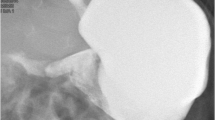Abstract
Background
Gastric volvulus in children is uncommon, and characteristic radiographic findings might not be recognized.
Objective
To present the spectrum of clinical and imaging findings, correlate the type of gastric volvulus with clinical outcome, and identify imaging findings to aid in early diagnosis.
Materials and methods
Medical records and imaging findings of ten children with gastric volvulus were reviewed. Imaging included abdominal radiographs, upper gastrointestinal (UGI) series, and CT. The diagnosis (organoaxial, mesenteroaxial or mixed type) was made on the UGI series (n = 9) and CT (n = 1), and confirmed surgically in seven children.
Results
Patients were classified based on presentation: four acute, four chronic, and two neonatal. All of the acute group (three mesenteroaxial and one mixed type) had abnormal radiographic findings: three spherical gastric distension, four paucity of distal gas, three elevated left hemidiaphragm, one overlapping pylorus and gastric fundus, one unusual nasogastric tube course, and one situs inversus. All underwent emergent surgery. Three had diaphragmatic abnormalities. One had heterotaxy. Patients in the chronic group (three organoaxial, one mesenteroaxial) had long-standing symptoms. Most had associated neurologic abnormalities. In the neonatal group, organoaxial volvulus was found incidentally on the UGI series.
Conclusion
A spectrum of findings in gastric volvulus exists. Mesenteroaxial volvulus has greater morbidity and mortality. Radiographic findings of spherical gastric dilatation, paucity of distal gas and diaphragmatic elevation are suggestive of acute volvulus, particularly in patients with predisposing factors.








Similar content being viewed by others
References
Basaran U, Inan M, Ayhan S et al (2002) Acute gastric volvulus due to deficiency of the gastrocolic ligament in a newborn. Eur J Pediatr 161:288–290
Andiran F, Tanyel FC, Hicsonmez A (1995) Acute abdomen due to gastric volvulus: diagnostic value of a single plain radiograph. Pediatr Radiol 25:S240
Shivanand G, Seema S, Srivastava D et al (2003) Gastric volvulus acute and chronic presentation. Clin Imaging 27:265–268
Campbell J (1979) Neonatal gastric volvulus. AJR 132:723–725
Ziprkowski M, Teele R (1979) Gastric volvulus in childhood. AJR 132:921–925
Dalgaard JR (1952) Volvulus of the stomach. Acta Chir Scand 103:131–153
Al-Salem A (2000) Intrathoracic gastric volvulus in infancy. Pediatr Radiol 30:842–845
Mayo A, Erez I, Lazar L et al (2001) Volvulus of the stomach in childhood: the spectrum of the disease. Pediatr Emerg Care 17:344–348
Qazi A, Awadalla S (2004) Wandering spleen: a rare cause of mesenteroaxial gastric volvulus. Pediatr Surg Int 20:878–880
Spector J, Chappell J (2000) Gastric volvulus associated with wandering spleen in a child. J Pediatr Surg 35:641–642
Uc A, Kao S, Sanders K et al (1998) Gastric volvulus and the wandering spleen. Am J Gastroenterol 93:1146–1148
Pelizzo G, Lembo M, Franchella A et al (2001) Gastric volvulus associated with congenital diaphragmatic hernia, wandering spleen, and intrathoracic left kidney: CT findings. Abdom Imaging 26:306–308
Feldman M (2002) Gastric volvulus. In: Feldman M, Friedman LS, Sleisenger MH (eds) Sleisenger and Fordtran’s gastrointestinal and liver disease, 7th edn. Saunders, Philadelphia, pp 373–375
Oh A, Gulati G, Sherman M et al (2000) Bilateral eventration of the diaphragm with perforated gastric volvulus in an adolescent. J Pediatr Surg 35:1824–1826
Franco A, Vaughan K, Vukcevic Z et al (2005) Gastric volvulus as a complication of liver transplant. Pediatr Radiol 35:327–329
Kuenzler K, Wolfson P, Murphy S (2003) Gastric volvulus after laparoscopic Nissen fundoplication with gastrostomy. J Pediatr Surg 38:1241–1243
Sty J, Wells R, Starshak R et al (1991) Diagnostic imaging of infants and children, vol 1. Aspen, NY, pp 161–162
Darani A, Mendoza-Sagaon M, Reinberg O (2005) Gastric volvulus in children. J Pediatr Surg 40:855–858
Elhalaby E, Mashaly E (2001) Infants with radiologic diagnosis of gastric volvulus: are they over-treated? Pediatr Surg Int 17:596–600
Bautista-Casasnovas A, Varela-Cives R, Fernandez-Bustillo J et al (2002) Chronic gastric volvulus: is it so rare? Eur J Pediatr Surg 12:111–115
Al-Salem AM (2007) Acute and chronic gastric volvulus in infants and children: who should be treated surgically? Pediatr Surg Int 23:1095–1099
Author information
Authors and Affiliations
Corresponding author
Rights and permissions
About this article
Cite this article
Oh, S.K., Han, B.K., Levin, T.L. et al. Gastric volvulus in children: the twists and turns of an unusual entity. Pediatr Radiol 38, 297–304 (2008). https://doi.org/10.1007/s00247-007-0709-5
Received:
Revised:
Accepted:
Published:
Issue Date:
DOI: https://doi.org/10.1007/s00247-007-0709-5




